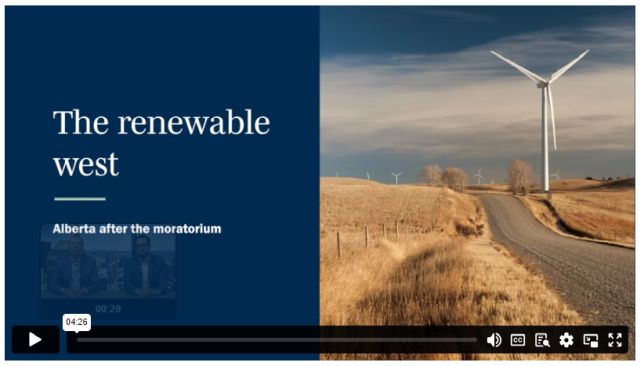Video transcript
Lou Cusano (00:05): Alberta's moratorium has ended and has impacted how renewable development will proceed in the province. To recap, the Government of Alberta instituted a pause on renewable power plant approvals on August 3rd, 2023. This moratorium was in place until February 29th, 2024. The purpose was to permit the Alberta Utilities Commission to inquire into certain issues relating to the rapid development of renewables in Alberta.
The issues were split into two modules: Module A considered land use, viewscapes and reclamation, Module B considered the impact of the increasing growth of renewables on the generation supply mix and system reliability. As of the date of this video, only the Module A report has been publicly released.
Gino Bruni (00:55): That's right, Lou. The Module A report has led to certain proposed legislation policy and regulatory changes for renewable power projects in Alberta. These include mandatory reclamation, security requirements, and an automatic right for municipalities to participate in regulatory proceedings for the approval of such projects. However, the change that is perhaps the most impactful in terms of the development of power projects is the classification of three land area zones, where renewables either cannot be built, or development will be significantly restricted.
The first zone is Class I and Class II of agricultural lands. This is where no new development of renewables in this area is permitted, unless a proponent can demonstrate the ability for such development and agricultural uses to coexist. But the government has yet to provide details on how this requirement may be met. The second restricted zone is called a "buffer" or "no-go" zone, where wind development will not be permitted, and other proposed development may be subject to a visual impact assessment prior to approval.
The buffer or no-go zones are located mainly on the eastern slopes of the Rockies. In addition to these zones, the government has also identified Visual Impact Assessment Zones around some, but not all, of the Unesco Heritage Sites and provincial parks in the province.
Lou Cusano (02:17): In terms of timing, the government plans to implement these restricted zones and the other legislation policy and regulatory changes resulting from the Module A inquiry before the end of this year. The government has also stated that the mandatory reclamation requirements will apply to all approvals issued on or after March 1st, 2024. Notwithstanding this, the Alberta Utilities Commission has begun considering these changes in its assessment of power plant approvals.
For example, in a recent Alberta Utilities Commission proceeding, in response to the announced changes, the commission provided the project proponent the opportunity to provide a visual impact assessment for a project near Cypress Hills Provincial Park, where one of the province's visual impact assessment zones is located.
The proponent argued that the consideration of this map and the government's upcoming changes regarding visual impacts was not appropriate, since its application was simply to amend an existing power plant approval granted prior to the moratorium. The Commission disagreed, and it did so on the basis that visual impacts were part of its public interest assessment of the wind power plant.
In terms of future projects, it is estimated that 57 prospective renewable projects worth approximately $14 billion could be impacted by the restricted zones, and it is also notable that none of these restrictions apply to other forms of development, such as oil and gas facilities.
Gino Bruni (03:49): Thanks, Lou. As I mentioned, the Module B report is not yet public, and any changes resulting from that inquiry are unknown at this time. The changes resulting from both Module A and Module B will have an impact on the development of renewable projects in Alberta. However, the exact impact and how the industry responds will become clear in the coming months and years as these changes are implemented into legislation, rules and the regulatory process for the approval of renewable projects.
In other words, Lou, stay tuned.
The content of this article is intended to provide a general guide to the subject matter. Specialist advice should be sought about your specific circumstances.



